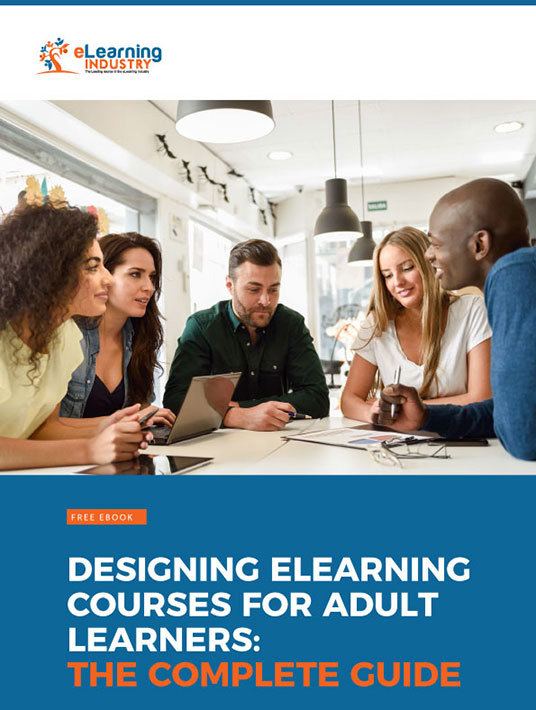How To Create eLearning Courses For Adult Learners
Adult learners are pressed for time. They're dealing with work obligations, personal commitments, and everyday stresses that vie for their attention. As a result, they need immediate access to information that caters to their personal goals and objectives. Furthermore, adult learners are looking for practical online training resources that help them overcome obstacles and fulfill their potential. Here are 8 tips to create eLearning courses for adult learners.

1. Create A Detailed eLearning Course Outline
Before adult learners join an eLearning course, they typically read the eLearning course outline or summary. The eLearning course outline should describe what your eLearning course can offer a participant. It should include an overview of the topics, and a detailed description of learning objectives and tasks the online learner must perform, as well as which online training certificate an online participant can obtain from the eLearning course. To ensure an eLearning course outline is clear for your adult learners, it is advisable to clearly identify the benchmarks of your eLearning course. You should also include how you will evaluate online learners' assignments, and how they will progress through the eLearning content you provide.
2. Mention Your Qualifications
Adult learners want to be sure that you are qualified to provide an eLearning course. They may even search for any relevant information on your website or review other sites before they enroll. For this reason, you should be fully transparent about your online instructors and staff. Mention their professional qualifications and the associations they belong to. For example, if you are providing an eLearning course that pertains to a college or a university, be sure to display this clearly on your website. It's also wise to include accreditations, certifications, or any other noteworthy awards that your organization has received.
3. Get Your Resources Straight
Adult learners will need quick access to the eLearning course material. They don't have time to sift through an entire eLearning course catalog to find relevant information. It's a good idea to provide your adult learners with an overview of their personalized resources. This may consist of texts, multimedia, and real-world activities that are based on their individual needs. To keep your adult learners engaged you can also provide them with links for further study. For example, references to another eLearning course you offer, or free online training resources provided by a noted college or university.
4. Clarify Grading Criteria
eLearning content can be evaluated in different ways. It's important to explain to prospective eLearning course participants how their online assignments and assessments will be graded and when. For example, they will receive a progress report every month, or upon completion of each pre-determined milestone. During the eLearning course, you should also keep your adult learners engaged by giving them appropriate eLearning feedback on their coursework. In addition, be clear about the skills, knowledge, and tasks you are focusing on. Online learners, for instance, must be able to perform each step of the process during the simulation to receive a passing grade.
5. Define The Scope Of The eLearning Course
Certain eLearning courses can take a couple of days, while others can take several months. Therefore, it is essential to give your adult learners a clear overview of the duration of the eLearning course. In addition to an overall course duration, you must also include the time commitment required from each online learner. For example, how long does an adult learner need to study to pass this eLearning course? Or how many hours does an online learner have to spend on coursework during an average week? By including such information, the adult learner can determine whether or not an eLearning course is suitable for their schedules.
6. Give Adult Learners A Feedback Outlet
Some adult learners prefer to read about the experiences from past eLearning course participants before they commit to an eLearning course. This is where a forum comes in handy. Adult learners can discuss and exchange information about the eLearning course, as well as offer insight. You can also place some reviews or testimonials from former eLearning course participants on your website. If you are creating an eLearning course for the first time, provide a discussion platform where current online learners can discuss the eLearning course. This will serve as a valuable reference tool for future eLearning programs you provide.
7. Highlight eLearning Course Policies
No matter what kind of eLearning course you are offering, there are always rules to which online learners must abide. This should cover regulations regarding course payments to codes of conduct for online learners when interacting with their peers. To avoid problems or confusion during your eLearning course, make sure that you have all your eLearning course policies clearly in place. And don’t forget to post them in a prominent spot on your website, social media pages, and forums. It's also wise to solicit input from your online learners regarding the eLearning course policies. They'll appreciate the fact that you value and respect their opinions. Thus, they are more likely to follow the rules and create a more positive eLearning environment for everyone involved.
8. Assess Their Skills
Skills are the currency of modern life. For this reason, you should assess your adult learners' skills to see where they stand and where they need to improve. Invite them to participate in simulations, branching scenarios, and serious games that put their skill sets to the test. Then, highlight their strengths and gaps so that they can utilize relevant online training resources. For example, online training tutorials or demos that showcase favorable behaviors which they can mimic in the real world.
Adult learners want to know what they can expect from an eLearning course, but also what they can get out of it. That's why it's essential to outline your eLearning course in detail on your website, social media sites, and eLearning platform. Let online learners know the benefits they can receive if they are willing to get involved and stay active in the eLearning community.
Are you interested in learning more about how to create eLearning courses for Adult Learners? Download our free eBook Designing eLearning Courses For Adult Learners: The Complete Guide to learn about the characteristics of adult learners, what motivates them, the most appropriate Instructional Design models and Theories for adult learners, as well as additional facts and stats you need to know about this particular audience.






